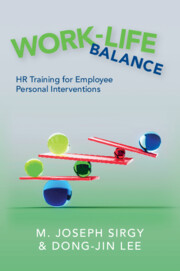Book contents
- Work-Life Balance
- Work-Life Balance
- Copyright page
- Contents
- Figures
- Tables
- Part I Making the Case for Work-Life Balance
- Part II Behavior-Based Personal Interventions of Work-Life Balance
- Chapter 4 Engaging in Multiple Roles and Domains
- Chapter 5 Increasing Role Enrichment
- Chapter 6 Engaging in Behavior-Based Compensation
- Chapter 7 Managing Role Conflict
- Chapter 8 Creating Role Balance
- Part III Cognition-Based Personal Interventions of Work-Life Balance
- Part IV Epilogue
- Index
- References
Chapter 8 - Creating Role Balance
from Part II - Behavior-Based Personal Interventions of Work-Life Balance
Published online by Cambridge University Press: 19 January 2023
- Work-Life Balance
- Work-Life Balance
- Copyright page
- Contents
- Figures
- Tables
- Part I Making the Case for Work-Life Balance
- Part II Behavior-Based Personal Interventions of Work-Life Balance
- Chapter 4 Engaging in Multiple Roles and Domains
- Chapter 5 Increasing Role Enrichment
- Chapter 6 Engaging in Behavior-Based Compensation
- Chapter 7 Managing Role Conflict
- Chapter 8 Creating Role Balance
- Part III Cognition-Based Personal Interventions of Work-Life Balance
- Part IV Epilogue
- Index
- References
Summary
In this chapter we discuss another behavior-based personal intervention, namely role balance. Role balance involves engaging in balanced activities— balanced between maintenance activities (those designed to maintain role functioning and meet basic needs) and flourishing activities (those designed to allow the individual to meet growth needs). Specifically, we describe some maintenance and flourishing activities that are essential to creating role balance in work life and nonwork domains (e.g., family life, health and safety, love life, financial life, social life, leisure life, and cultural life). We then discuss how instructors can implement the role balance principle in workshops designed to train employees how to increase work-life balance.
Keywords
- Type
- Chapter
- Information
- Work-Life BalanceHR Training for Employee Personal Interventions, pp. 88 - 100Publisher: Cambridge University PressPrint publication year: 2023



